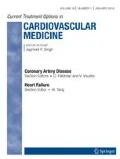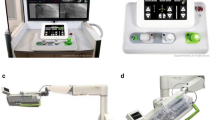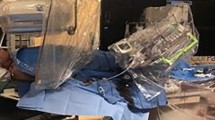Abstract
Purpose of review
The goal of this review is to describe the benefits and limitations of robotic-assisted percutaneous coronary intervention (PCI), the most important and recent clinical data, and the future applications as robotic technology continues to develop.
Recent findings
Robotic-assisted PCI can reduce occupational hazards of ionizing radiation exposure and orthopedic injury to the interventional cardiologist while offering increased precision and fine control that may confer benefit to the patient. Recent studies have suggested the efficacy and safety of robotic-assisted PCI, yet widespread use of the technology has not been fully adopted due to limitations of the current technology and high costs.
Summary
Robotic-assisted PCI has potential to benefit both the operator and the patient. Despite some limitations of robotic-assisted PCI, it can safely and effectively be used in many patients with coronary artery disease requiring PCI. The value proposition for robotic-assisted PCI will depend on the evolution of robotic systems and its applicability to more complex coronary lesions, peripheral arterial interventions, and telemedicine.

Similar content being viewed by others
References and Recommended Reading
Papers of particular interest, published recently, have been highlighted as: • Of importance •• Of major importance
Kapur V, Smilowitz NR, Weisz G. Complex robotic-enhanced percutaneous coronary intervention. Catheter Cardiovasc Interv. 2014;83:915–21.
•• Mahmud E, Naghi J, Ang L, et al. Demonstration of the safety and feasibility of robotically assisted percutaneous coronary intervention in complex coronary lesions: results of the CORA-PCI study (Complex Robotically Assisted Percutaneous Coronary Intervention). J Am Coll Cardiol Intv. 2017;10:1320–7. Important study evaluating the safety, feasibility, clinical success, and technical success of CorPath 200 in an all-comer population at a single center.
• Maor E, Eleid MF, Gulati R, et al. Current and future use of robotic devices to perform percutaneous coronary interventions: a review. J Am Heart Assoc. 2017;6:e006239. A comprehensive review of robotic-assisted PCI.
Andreassi MG, Piccaluga E, Guagliumi G, et al. Occupational health risks in cardiac catheterization laboratory workers. Circ Cardiovasc Interv. 2016;9:e003273.
Picano E, Vano E. Radiation exposure as an occupational hazard. EuroIntervention. 2012;8:649–53.
Vano E, Gonzalez L, Fernandez JM, et al. Occupational radiation doses in interventional cardiology: a 15-year follow-up. Br J Radiol. 2006;79:383–8.
Vano E, Kleiman NJ, Duran A, et al. Radiation-associated lens opacities in catheterization personnel: results of a survey and direct assessments. J Vasc Interv Radiol. 2013;24:197–204.
Karatasakis A, Brilakis HS, Danek BA, et al. Radiation-associated lens changes in the cardiac catheterization laboratory: results from the IC-CATARACT (CATaracts Attributed to Radiation in the CaTh lab) study. Catheter Cardiovasc Interv. 2017; https://doi.org/10.1002/ccd.27173.
Vano E, Kleiman NJ, Duran A, et al. Radiation cataract risk in interventional cardiology personnel. Radiat Res. 2010;174:490–5.
Ciraj-Bjelac O, Rehani MM, Sim KH, et al. Risk for radiation-induced cataract for staff in interventional cardiology: is there reason for concern? Catheter Cardiovasc Interv. 2010;76:826–34.
Ciraj-Bjelac O, Rehnani MM, Minamoto A, et al. Radiation-induced eye lens changes and risk for cataract in interventional cardiology. Cardiology. 2012;123:168–71.
Klein LW, Miller DL, Balter S, et al. occupational health hazards in the interventional laboratory: time for a safer environment. J Vasc Inter Radiol. 2009;20:S278–83.
Smilowitz NR, Balter S, Weisz G. Occupational hazards of interventional cardiology. CRM. 2013;14:223–8.
Preston DL, Ron E, Tokuoka S, et al. Solid cancer incidence in atomic bomb survivors: 1958–1998. Radiat Res. 2007;168:1–64.
Hasan F, Bonatti J. Robotically assisted percutaneous coronary intervention: benefits to the patient and the cardiologist. Expert Rev Cardiovasc Ther. 2015;13(11):1165–8.
Andreassi MG, Cioppa A, Botto N, et al. Somatic DNA damage in interventional cardiologists: a case-control study. FASEB J. 2005;19:998–9.
Roguin A, Goldstein J, Bar O, et al. Brain and neck tumors among physicians performing interventional procedures. Am J Cardiol. 2013;111:1368–72.
Vano E, Gonzalez L, Guibelalde E, et al. Radiation exposure to medical staff in interventional and cardiac radiology. Br J Radiol. 1998;71:954–60.
•• Weisz G, Metzger C, Caputo RP, et al. Safety and feasibility of robotic percutaneous coronary intervention: PRECISE (Percutaneous Robotically-Enhanced Coronary Intervention) study. J Am Coll Cardiol. 2013;61:1596–600. First pivotal trial assessing the safety, technical success, and clinical success of CorPath 200 in simple coronary lesions.
Khalil TM, Rosomoff HL. Ergonomics. Back pain: a guide to prevention and rehabilitation. New York: Van Nostrand Reinhold; 1993.
Goldstein JA, Balter S, Cowley M, et al. Occupational hazards of interventional cardiologists: prevalence of orthopedic health problems in contemporary practice. Catheter Cardiovasc Interv. 2004;63:407–11.
Ross AM, Segal J, Borenstein D, et al. Prevalence of spinal disc disease among interventional cardiologists. Am J Cardiol. 1997;79:68–70.
Campbell PT, Mahmud E, Marshall JJ. Interoperator and intraoperator (in)accuracy of stent selection based on visual estimation. Catheter Cardiovasc Interv. 2015;86(7):1777–83.
Costa MA, Angiolilo DJ, Tannenbaum M, et al. Impact of stent deployment procedural factors on long-term effectivenss and safety of sirolimus-eluting stents (final results of the multicenter prospective STLLR trial). Am J Cardiol. 2008;101:1704–11.
Raber L, Juni P, Wandel S, et al. Impact of stent overlap on angiographic and long-term clinical outcome in patients undergoing drug-eluting stent implantation. J Am Coll Cardiol. 2010;55(12):1178–88.
•• Campbell PT, Kruse KR, Kroll CR, et al. The impact of precise robotic lesion length measurement on stent length selection: ramifications for stent savings. CRM. 2015;16:348–50. Study that compared robotic-assisted PCI measurement of lesion length and stent length selection to visual estimation, and the implications on stent savings.
Mauri L, O’Malley AJ, Cutlip DE, et al. Effects of stent length and lesion length of coronary restenosis. Am J Cardiol. 2004;93:1340–6.
Mauri L, O’Malley AJ, Popma JJ, et al. Comparison of thrombosis and restenosis risk from stent length of sirolimus-eluting stents versus bare metal stents. Am J Cardiol. 2005;95:1140–5.
Pourdjabber A, Ang L, Reeves RR, et al. The development of robotic technology in cardiac and vascular interventions. Rambam Maimonides Med J. 2017;8(3):e0030.
Mahmud E, Dominguez A, Bahadorani J. First-in-human robotic percutaneous coronary intervention for unprotected left main stenosis. Catheter Cardiovasc Interv. 2016;88:565–70.
Swaminathan RV, Rao SV. Robotic-assisted transradial diagnostic coronary angiography. Catheter Cardiovasc Interv. 2018; https://doi.org/10.1002/ccd.27480.
• Mahmud E, Schmid F, Kalmer P, et al. Feasibility and safety of robotic peripheral vascular interventions: results of the RAPID trial. J Am Coll Cardiol Intv. 2016;9:2058–64. Small study of 20 patients demonstrating the safety and feasibility of CorPath 200 in femoropopliteal diesease.
• Mangels DR, Giri J, Hirshfeld J, et al. Robotic-assisted percutaneous coronary intervention. Catheter Cardiovasc Interv. 2017;90(6):948–55. Review of robotic-assisted PCI and limitations.
Brodmann M. Robotic-assisted peripheral intervention for peripheral arterial disease II (RAPID II). https://clinicaltrials.gov/ct2/show/NCT02742077. Last updated: December 16, 2016.
Behnamfar O, Pourdjabbar A, Yalvac E, et al. First case of robotic percutaneous vascular intervention for below-the-knee peripheral arterial disease. J Invasive Cardiol. 2016;28(11):E128–31.
•• Madder RD, VanOosterhout SM, Jacoby ME, et al. Percutaneous coronary intervention using a combination of robotics and telecommunications by an operator in a separate physical location from the patient: an early exploration into the feasibility of telestenting (the REMOTE-PCI study). Eurointervention. 2017;12:1569–76. Thought-provoking trial introducing the concept of robotic-assisted PCI for telestenting.
Mahmud, E. Precision GRX Registry. https://clinicaltrials.gov/ct2/show/record/NCT03278301. Last updated: September 11, 2017.
Author information
Authors and Affiliations
Corresponding author
Ethics declarations
Conflict of Interest
The authors declare that they have no conflict of interest.
Human and Animal Rights and Informed Consent
This article does not contain any studies with human or animal subjects performed by any of the authors.
Additional information
This article is part of the Topical Collection on Coronary Artery Disease
Rights and permissions
About this article
Cite this article
Lo, N., Gutierrez, J.A. & Swaminathan, R.V. Robotic-Assisted Percutaneous Coronary Intervention. Curr Treat Options Cardio Med 20, 14 (2018). https://doi.org/10.1007/s11936-018-0608-0
Published:
DOI: https://doi.org/10.1007/s11936-018-0608-0




